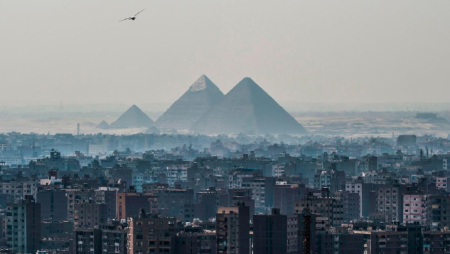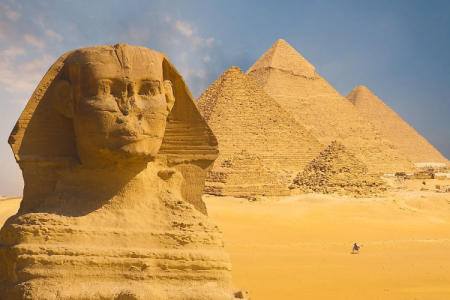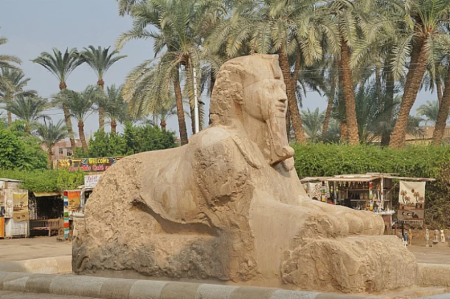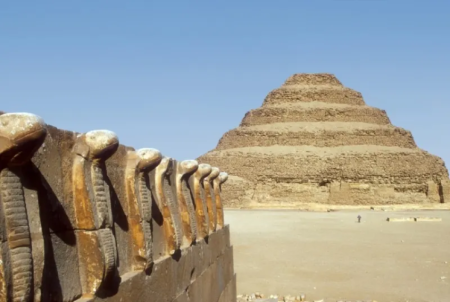The Valley Temple

The Valley Temple of Khafre – A Timeless Masterpiece of Ancient Egyptian Architecture
Nestled at the foot of the Great Pyramids of Giza, the Valley Temple of Khafre stands as an enduring symbol of ancient Egyptian ingenuity, artistry, and religious devotion. This temple, one of the best-preserved structures from the Old Kingdom, offers a unique window into the spiritual beliefs and engineering prowess that defined Egypt's golden age. The Valley Temple was not just a ceremonial site—it was a sacred place of purification, where priests prepared Pharaoh Khafre’s body for the afterlife. Built around 2520 BCE, it remains a cornerstone of Egypt’s monumental heritage and continues to fascinate archaeologists, travelers, and historians alike.
Visitors walking into the Valley Temple are immediately transported back to an era where stone spoke the language of eternity. The massive limestone and granite blocks, polished to perfection, reflect an aesthetic that’s both minimalist and profoundly powerful. This extraordinary site, located near the enigmatic Sphinx Statue, forms part of the pyramid complex of Pharaoh Khafre, the builder of the second-largest pyramid on the Giza Plateau. The temple’s timeless design, precision-cut architecture, and mysterious aura make it a must-see for anyone exploring Egypt’s ancient wonders. Whether you’re on one of the incredible Egypt Travel Packages or pursuing a personal passion for archaeology, the Valley Temple promises an unforgettable encounter with ancient history carved in stone.
Origins and Historical Importance of the Valley Temple
The Valley Temple of Khafre was constructed during Egypt’s Fourth Dynasty, around 2520 BCE, as part of the king’s pyramid complex. It served as the starting point for the pharaoh’s journey to the afterlife. Connected to Khafre’s pyramid by a causeway, the temple marked the transition from the earthly realm to the divine. Here, priests performed the essential purification and mummification rituals before transporting the pharaoh’s body to his pyramid tomb. This sacred site was not only functional but deeply symbolic—it represented the renewal of life and the eternal cycle of resurrection that defined ancient Egyptian belief systems.
What sets the Valley Temple apart from other funerary structures is its remarkable state of preservation. Unlike other temples that succumbed to time or conquest, Khafre’s Valley Temple retained much of its original form. Archaeological evidence suggests that its construction used colossal blocks of limestone weighing up to 200 tons each, perfectly interlocked without mortar. The craftsmanship reveals an astonishing mastery of geometry and architecture, a testament to Egypt’s unmatched stone masonry skills. Historians assert that this temple's layout influenced later funerary complexes across Egypt, including structures in Sakkara Necropolis and Memphis Egypt, the old Egyptian capital.
Architectural Brilliance: The Design and Layout of the Valley Temple
The Valley Temple’s design is an exquisite example of early Egyptian architectural symmetry and simplicity. Its rectangular plan, precise axes, and alignment with celestial points reflect not just engineering excellence but a profound spiritual understanding of cosmic harmony. The temple’s construction materials—core limestone blocks sheathed in red granite—create a stunning contrast of color and texture. The floors, made of alabaster, once gleamed under flickering torchlight, creating a serene and sacred environment where ritual purity was paramount.
The interior of the temple features a series of massive pillars supporting flat stone roofs. Two main halls lead to smaller chambers used for rituals and storage of sacred objects. Interestingly, archaeologists discovered statues of Pharaoh Khafre within the temple, including the world-famous diorite statue now housed in the Egyptian Museum of Cairo. This statue, depicting Khafre seated on a throne protected by the falcon god Horus, embodies the divine kingship concept central to Egyptian theology. The temple’s design harmoniously combines strength and spirituality, underscoring the pharaoh’s eternal bond with the gods.
Religious Function and Ceremonial Practices
At its core, the Valley Temple of Khafre was a spiritual gateway. Priests used it to carry out purification rituals essential to ensuring the pharaoh’s passage into eternity. The embalming ceremonies conducted here aligned with the complex process of mummification, symbolizing death’s transformation into eternal life. Offerings, chants, and sacred rites filled the temple’s halls as the body of Khafre was ritually prepared to join the divine pantheon. The temple was also the site of the ‘Opening of the Mouth’ ceremony, a ritual restoring the deceased’s senses in the afterlife.
These rites connected the living and the dead, embodying the Egyptians’ profound faith in immortality. The temple’s architecture supported this symbolism through its spatial design—dark inner chambers represented death, while light-filled corridors symbolized rebirth. This duality reflected Egypt’s cyclical view of life, a concept still mirrored in the art and culture preserved across sites like The Valley of the Kings and Luxor Temple.
The Connection Between the Valley Temple and the Great Sphinx
One of the most intriguing aspects of the Valley Temple is its proximity and connection to the Great Sphinx. Many scholars believe that both monuments were part of a unified complex dedicated to Pharaoh Khafre. The alignment between the temple and the Sphinx suggests a symbolic correlation between divine kingship and solar worship. The Sphinx, representing the pharaoh as a godlike guardian, may have acted as the temple’s eternal sentinel. This spatial relationship reinforces the idea that the Valley Temple was not only a mortuary site but also a center of solar and royal cult worship.
Modern studies reveal that the same quarry supplied both the temple’s limestone blocks and the Sphinx’s body, further confirming their intertwined construction. The harmony between these structures exemplifies the Egyptians’ architectural sophistication and their spiritual integration of art, astronomy, and theology.
Preservation, Excavation, and Modern Discovery
The Valley Temple was first explored in the 19th century during extensive excavations at Giza. Archaeologists uncovered the temple buried under centuries of sand, remarkably intact compared to other ancient sites. Its polished floors, massive columns, and surviving statues stunned researchers, fueling global fascination with Egyptology. Today, the Valley Temple stands as one of the best-preserved monuments of the Old Kingdom, offering an unfiltered glimpse into Egypt’s architectural genesis.
Conservation efforts continue to protect this invaluable site from environmental and human threats. The Egyptian government, along with international archaeological missions, regularly monitors the temple’s condition. Thanks to these efforts, visitors can still marvel at the same stone walls that once witnessed sacred rituals more than 4,000 years ago. For those embarking on Egypt Nile Cruises or guided Cairo Day Tours, exploring the Valley Temple is a highlight—a chance to stand where pharaohs were prepared for eternity.
The Valley Temple as a Testament to Ancient Egyptian Civilization
The Valley Temple epitomizes Egypt’s mastery of stone architecture, religious devotion, and eternal quest for immortality. Its enduring grandeur and symbolic meaning continue to inspire admiration and research. Every polished surface and precise alignment tells a story of a civilization attuned to cosmic balance and divine order. As visitors explore its corridors, they don’t just witness history—they experience it. The Valley Temple remains a sacred bridge between past and present, linking human craftsmanship to divine aspiration. Its timeless beauty ensures that Egypt’s ancient voice continues to echo across millennia.
Frequently Asked Questions About The Valley Temple
What was the Valley Temple used for?
The Valley Temple served as a purification and embalming site for Pharaoh Khafre. Priests conducted rituals to prepare the pharaoh’s body for burial and entry into the afterlife. It also functioned as a ceremonial space for offerings and religious rites associated with resurrection and divine worship.
Who built the Valley Temple of Khafre?
The Valley Temple was built during the reign of Pharaoh Khafre of Egypt’s Fourth Dynasty, around 2520 BCE. It formed part of his pyramid complex at Giza, which also includes the Great Pyramid and the Great Sphinx.
Where is the Valley Temple located?
The Valley Temple is located on the Giza Plateau near modern-day Giza City, just east of Khafre’s pyramid and adjacent to the Great Sphinx. It’s easily accessible from Cairo and forms part of Egypt’s most famous archaeological site.
What materials were used in the construction of the Valley Temple?
The temple was built primarily from local limestone and clad in polished red granite. The floors were made of alabaster, creating a luminous interior that reflected the light of torches and the sun, adding to the temple’s ethereal ambiance.
Can visitors explore the Valley Temple today?
Yes, the Valley Temple is open to visitors as part of the Giza Plateau’s archaeological complex. It’s a key stop for anyone exploring Egypt’s ancient treasures, whether through Egypt Luxury Tours or personalized historical excursions. Walking through its ancient halls offers a remarkable journey through time and spirituality.











